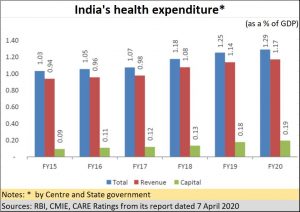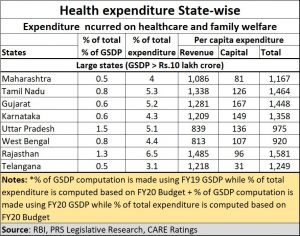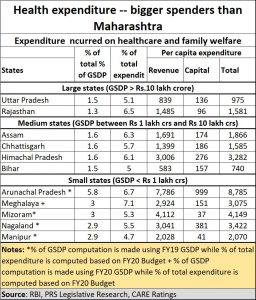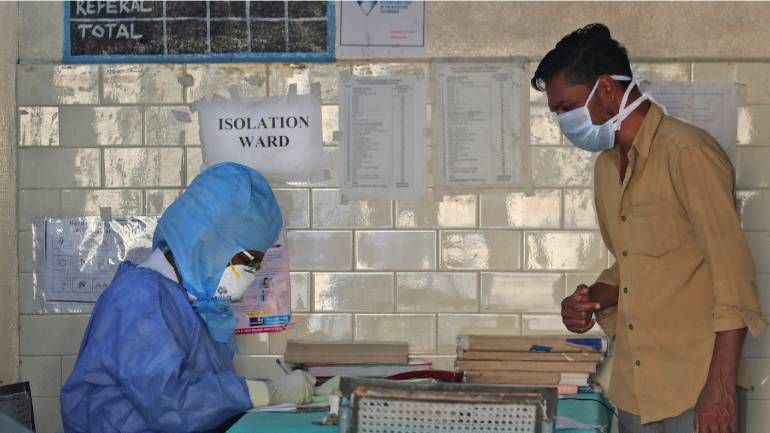A modified version of this report appeared at https://www.moneycontrol.com/news/economy/policy/coronavirus-pandemic-indias-poor-healthcare-spending-is-hurting-the-fight-5123081.html
Coronavirus and health – India paints a sorry picture
If the coronavirus is battering India, don’t be surprised. India has not paid attention to health services. The worst performer is Maharashtra. Not surprisingly, this state has been the worst affected.
RN Bhaskar — April 9, 2020
The adage that the sins of the past are heaped on the present is now coming true. India is being battered by the coronavirus epidemic. It tried to stop its spread by announcing a lockdown right in the beginning. But without supporting health infrastructure, the casualty rate is likely to go up.
 As the latest report from CARE Ratings (dated 7 April 2020) points out. India spent barely 1.29% of its GDP on health care. More dismal was its spending on capital expenditure – it stood at just 0.19%
As the latest report from CARE Ratings (dated 7 April 2020) points out. India spent barely 1.29% of its GDP on health care. More dismal was its spending on capital expenditure – it stood at just 0.19%
That could explain to a great extent why India did not do enough testing right from the start. The best managers of the coronavirus epidemic are acknowledged to be Germany, Japan, Singapore (https://www.moneycontrol.com/news/business/coronavirus-pandemic-an-opportunity-to-overhaul-indias-ailing-healthcare-sector-5079501.html) and South Korea. The order in which these countries should be placed is debatable. But what they did was to first test, then do a lot of contract tracing and subsequent isolation. Lockdowns were the last option. India chose the lockdown perhaps because it was the cheapest, not the most recommended.
 It is at such times that the irony of some of the government’s announcements begin to make even the die-hard supporters blanch and squirm. India announced the world’s largest healthcare scheme, Ayushman Bharat (https://www.moneycontrol.com/news/business/opinion-ayushman-bharat-is-a-great-concept-but-where-are-the-doctors-2851461.html), but failed to back up such an ambitious and even socially relevant scheme with enough money.
It is at such times that the irony of some of the government’s announcements begin to make even the die-hard supporters blanch and squirm. India announced the world’s largest healthcare scheme, Ayushman Bharat (https://www.moneycontrol.com/news/business/opinion-ayushman-bharat-is-a-great-concept-but-where-are-the-doctors-2851461.html), but failed to back up such an ambitious and even socially relevant scheme with enough money.
And as the epidemic rampages across the country, it also becomes clear that Maharashtra is the worst hit. But that should also not be surprising. Among the large states in India, Maharashtra spends the least (see table). It spent barely 0.5% of its GSDP (gross state domestic product), a percentage that is lower than other states. Even if one considers the share of healthcare expenditure as a percentage of revenues, Maharashtra fares rather poorly. Of course, there is one large state, Telangana, which has a lower number. So will the country’s leading industrial state now benchmark itself against Telangana?
Maharashtra’s case is more horrifying because it has spent more money in giving away flats to slum dwellers who were encouraged to squat on public land. The state broke one cut-off date after another, against the mandates of the courts, by passing ordinances and laws to allow more slums to emerge. Today it is the king among all the states in India when it comes to slum formation. (https://www.moneycontrol.com/news/india/coronavirus-pandemic-slums-are-new-hotspots-that-can-ravage-cities-5090381.html). In other words, it has spent more money and legislative time on slums than on healthcare.
And now it wants to waive in perpetuity all property taxes to be paid by ‘rehabilitated’ slum dwellers. As pointed out earlier, the reasons are obvious. Slumdwellers are voters, they help in siphoning away money meant for entitlements, and they also allow for real estate adventurism.
The sad part is that the state government did not ramp up its health services even as the density of people living in the slums went up. So now you have more people, more slums, less money and a rampaging epidemic. It is not surprising then that Maharashtra has been badly hit.
What is most worrying is that, with climate change, it is likely that new epidemics will keep on surfacing periodically. Maharashtra and India will be sitting ducks if health services (and education) are not ramped up as extremely urgent priorities.
 It may make sense at this stage to look at the states which do spend a lot more than Maharashtra (or even India) does. The best among them would be the North-Eastern states — see table. Arunachal Pradesh spends the most among Indian states on health services — 5.8%. Then come Meghalaya and Mizoram. Among medium states you have Assam and Chhatisgarh. Among the big states you find Uttar Pradesh and Rajasthan spending double the amount that Maharashtra does in terms of percentage of GSDP. Expect the North Eastern states to climb faster in terms of human capital development than other states because they spend more on education and health services.
It may make sense at this stage to look at the states which do spend a lot more than Maharashtra (or even India) does. The best among them would be the North-Eastern states — see table. Arunachal Pradesh spends the most among Indian states on health services — 5.8%. Then come Meghalaya and Mizoram. Among medium states you have Assam and Chhatisgarh. Among the big states you find Uttar Pradesh and Rajasthan spending double the amount that Maharashtra does in terms of percentage of GSDP. Expect the North Eastern states to climb faster in terms of human capital development than other states because they spend more on education and health services.
India cannot blame other countries, communities or people. It must first blame its policymakers. For allowing cities to get congested in the first place. For not putting into place measures to deal with any kind of spread of disease. And for not allocating enough money for health services and education.
That could also explain why India’s ranking on the World Banks’s Health Capital Index (HCI) is among the poorest in the world (https://www.moneycontrol.com/news/business/markets/opinion-do-the-stock-markets-care-for-economic-growth-3073061.html). Its scores are lower than Bangladesh, Sri Lanka and Nepal/ The only country in the neighbourhood which ranks lower than India is Pakistan. Is that again a new benchmark?
If India wants to find its place in the sun, it had better ramp up its healthcare and education expenditure.







































COMMENTS